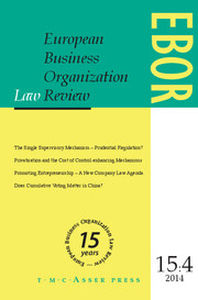Crossref Citations
This article has been cited by the following publications. This list is generated based on data provided by
Crossref.
Grazell, Jos
2006.
Advances in Corporate Finance and Asset Pricing.
p.
293.
Akkermans, Dirk
Van Ees, Hans
Hermes, Niels
Hooghiemstra, Reggy
Van der Laan, Gerwin
Postma, Theo
and
Van Witteloostuijn, Arjen
2007.
Corporate Governance in the Netherlands: an overview of the application of the Tabaksblat Code in 2004.
Corporate Governance: An International Review,
Vol. 15,
Issue. 6,
p.
1106.
Barrachdi, Faysal
2008.
Hedge Fund Activism and Corporate Governance: The State of the Art.
SSRN Electronic Journal,
Schnyder, Gerhard
2008.
Revisiting the Party Paradox of Finance Capitalism: Evidence from Switzerland, Sweden, and the Netherlands.
SSRN Electronic Journal,
de Jong, Abe
Röell, Ailsa
and
Westerhuis, Gerarda
2010.
Changing National Business Systems: Corporate Governance and Financing in the Netherlands, 1945–2005.
Business History Review,
Vol. 84,
Issue. 4,
p.
773.
Schnyder, Gerhard
2010.
Varieties of Insider Corporate Governance: Centre-Right Preferences and the Determinants of Reform in the Netherlands, Sweden and Switzerland.
SSRN Electronic Journal,
Cziraki, Peter
de Goeij, Peter
and
Renneboog, Luc
2011.
Corporate Governance Rules and Insider Trading Profits.
SSRN Electronic Journal,
Cziraki, Peter
de Goeij, Peter
and
Renneboog, Luc
2011.
Corporate Governance Rules and Insider Trading Profits.
SSRN Electronic Journal,
Hooghiemstra, Reggy
and
van Ees, Hans
2011.
Uniformity as response to soft law: Evidence from compliance and non‐compliance with the Dutch corporate governance code.
Regulation & Governance,
Vol. 5,
Issue. 4,
p.
480.
Schnyder, Gerhard
2011.
Revisiting the Party Paradox of Finance Capitalism: Social Democratic Preferences and Corporate Governance Reforms in Switzerland, Sweden, and the Netherlands.
Comparative Political Studies,
Vol. 44,
Issue. 2,
p.
184.
Ees, Hans van
and
Marra, Teye
2012.
Corporate Governance and Initial Public Offerings.
p.
306.
Hooghiemstra, Reggy
2012.
What determines the informativeness of firms' explanations for deviations from the Dutch corporate governance code?.
Accounting and Business Research,
Vol. 42,
Issue. 1,
p.
1.
Schnyder, Gerhard
2012.
Varieties of insider corporate governance: the determinants of business preferences and corporate governance reform in the Netherlands, Sweden and Switzerland.
Journal of European Public Policy,
Vol. 19,
Issue. 9,
p.
1434.
Honing, Sirik
2012.
Does Diversity in Executive Boards Make a Difference? Nationality Diversity and Firm Performance in German, Dutch and British Multinational Enterprises.
SSRN Electronic Journal,
Cziraki, Peter
De Goeij, Peter
and
Renneboog, Luc
2014.
Corporate Governance Rules and Insider Trading Profits.
Review of Finance,
Vol. 18,
Issue. 1,
p.
67.
Gelter, Martin
2016.
Employee Participation in Corporate Governance and Corporate Social Responsibility.
SSRN Electronic Journal,
Achtenhagen, Leona
Inwinkl, Petra
Björktorp, Jacob
and
Källenius, Robert
2018.
More than two decades after the Cadbury Report: How far has Sweden, as role model for corporate-governance practices, come?.
International Journal of Disclosure and Governance,
Vol. 15,
Issue. 4,
p.
235.
Renneboog, Luc
and
Szilagyi, Peter G.
2020.
How relevant is dividend policy under low shareholder protection?.
Journal of International Financial Markets, Institutions and Money,
Vol. 64,
Issue. ,
p.
100776.

